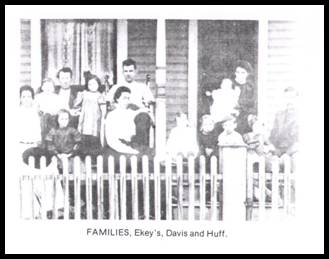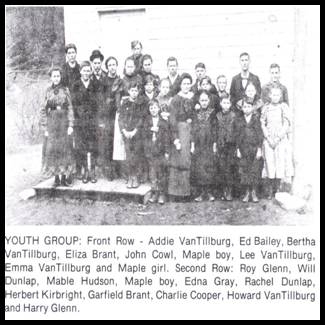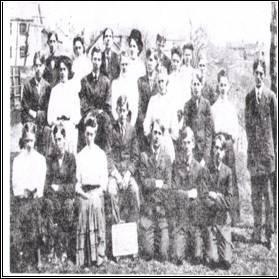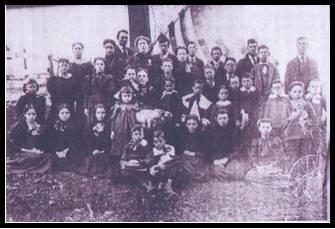{Thanks to Shirley Bartels for providing the following information.} Beginning in January 31st, 1918 is a list from the orginal school ledger the following school districts:
- Sugar Grove
- Shady Glenn
- Knoxville
- Shellys
- Island Creek
- New Somerset
- Holt
List of names 1918, refills under, refills in High School:
- Hazel Reed Wellsville, Paid $2.00
- Esther Swickard Toronto $2.00
- George --------- Toronto $5.00
- Grace Cooper Toronto $5.00
- Wilbur Leatherberry Toronto $5.00
- Arthur Johnston Toronto $5.00
- Frances McLain Toronto $5.00
- Martha Leatherberry Toronto $5.00
- Lattie McLain Toronto $5.00
- Ruth Johnston Toronto $5.00
- Richard Bray Toronto $5.00
- Eliner Snyder Toronto $5.00
- Beatrice Wiley Toronto $5.00
- Marion Morris Toronto $5.00
January 31, 1918 – The Board of Education of Knox Twp. Rural School Districts of Jefferson County, Ohio met in regular session. Minutes of Dec 28, 1917 read and approved.
- J.W. Wallace, supplies $4.19
- Chas. Cattrell, coal & supplies $20.70
- Book Company $10.40
- Vida E. Cooper, teaching $60.00
- Lucy Cooper, teaching $55.00
- Emily Edmiston, teaching $60.00
- Gladys Swickard, teaching $60.00
- Cook Swickard, janitor $60.00
- Anna Edmiston, teaching $60.00
- Donald VanDyke, teaching $55.00
Other familiar surnames listed in school ledgers: Robert Schillings (author of the series of Yellow Creek Tales), Paisley, Cunningham, Sapp, Walker, Scott, Shelly, Campbell, Eakin, Elson, VanTilburg, Runyon, Yocum, Grimm, Taggart, McConnell, Lutton, Calhoun, Bray, Swickard, Stokes, and Culp to just name a few!
COMMON SCHOOL REGISTER – Sugar Grove School, term commencing Sept. 8, 1924 and ending Dec. 26, 1924, Anna Edmiston, teacher. The enrollment shows their attendance records and if they moved and where they moved. Students enrolled are as follows:
James Vance Catherine Hartline
Irene Ward Elizabeth Warren
Fouso Grudier Wilmont Vance
Doris Draa Catherine Bunner
Chirstena Ward Edward Hartline
Tony Chickerell Calvin Warren
Emma Hartline Thomas Draa
Leona Stocks Pauline Stocks
Catherine Johnson Junior Warren
Paul Stocks Catherine Stocks
William Ward Alex Hartline
Calvin Bunner Charles VanTilburg
Dale Draa Fred Goodman
January 5, 1925 through May of 1925 is next in the ledger book. Next is Sept. 7, 1925 to Dec. 24, 1925. By 1925, the surname STOCKS was spelled, STOCK. Eleanor St. Clair was the teacher. Students for Sept. 6, 1926 and ending Dec. 24, 1926, teacher Lucile Fouch:
Katheryn Bunner Leona Duerelle
Eluara Hartline Emma Hartline
Kathryn Johnston Elizabeth Warren
Ruth Warren Ruth Warren
Elda Warren Pauline Stocks
Katheryn Stocks Leona Stocks
Calvin Bunner Audrey Bunner
George Chapman George Chapman
Culling Chapman Carson Chapman
William Duerelle Fougo Grudier
Edward Hartline Alex Hartline
Charles VanTilburg Calvin Warrner
Junior Warren Wilmont Vance
Paul Stocks Albert Stocks
Albert Schoolcraft William Schoolcraft
Eva Schoolcraft Myrtle Schoolcraft
Percent of attendance: 91 % girls, 89% boys.
By Sept. 6, 1927, ending April 20, 1928 – new pupils are Albert Stocks, Binegar, Risnear, Higgins, Culp, Vaoew, Runyon, and Eddy. Visitors to the school in the register: Supt. Lloyd (from Amsterdam) on Sept 14, 1924, Alan Ward (from Toronto) on Nov. 13, 1924, Audrey Bunner (Toronto), Nov. 14, 1924, visiting Dec. 24, 1924 from Toronto; Mrs. Harry Cooper, Mr. Chas. Vance, Mr. Thos. Warren, Ruth Warren, Elda Warren, Mrs. Jno. Johnston, Mrs. Jas. Cooper, Gerald Cooper, on Dec. 1925 Miss Sara VanTilburg visited (Toronto). Visiting in 1926 was Supt. Linton (Steubenville), Ed Chapman (Toronto), and Helen Vance (Toronto). Visitors in 1927 were, Jimmie Cooper (Toronto), Chick Johnston (Toronto), Oneida Hartline (Toronto), Philip Runyon and Charles Runyon (Sugar Grove) on April 6, 1927.
{Knoxville Area History, 1802 – 1976 Beginning on page 7}The Knoxville M.E. Church was organized between 1830 and 1835. The first class met for sometime in a schoolhouse, then moved to a brick building…
The old Shady Glenn School {off of present day JFK road} was located down in the hollow of the Snyder farm, where it was the center of school for both Warren Ridge and Shady Glenn. Part of the stone foundataion can still be seen.
In 1909, a new Shady Glenn school was built on property given by Ellsworth Snyder up on top of the hill along the Croxton Run Road, now John F. Kennedy Highway. In 1951, this school was closed and sold to Wm. Carmen and turned into a house.
The children were bussed to Knoxville Consolidated school. Teachers that taught at Shady Glenn at both the old and on top of the Shady Glenn Hill are: John Jeffrey, Emily Edminston Cooper, Mary Alexander Elson, Anna Edminston, Donald VanDyke, Beatrice Wasley Johnston, Mrs. Cohen, Grace Trimmer and Frieda Snyder Eddy. Frieda taught from 1940 to 1951. Mrs. Eddy also taught at Shelly’s from 1936 to 1940 and at Knoxville from 1951 to 1963.
HIGH SCHOOL
The old school that stands in Knoxville now was also used a high school. The students only went there two years and then had to finish somewhere else. Before they did away with the high school part altogether, the students were bussed to Toronto. At that time the drivers owned their own buses. Two drivers that come to mind are Ford Cattrell and George Bartels. The school was sold when the new Knoxville Grade School was built. It was bought by the late Clifford Wilson and Elmer Snyder who held public auctions there for several years.
KNOXVILLE GRADE SCHOOL
Many fine souls of the past several generations have had the opportunity to begin, and many complete, their education in the Knoxville area. Even when the town was founded, education was a neccessity among the settlers. Among businesses of the community were drug stores, three churches, a building and loan, three cattle drovers, two dress makers, and one tailor shop and two academies, Andrews and Tidballs. As the years passed, the academy ceased from being and several schools were erected to take their place. One of those schools that can still be remembered rather well, still stands adjoining the Knox Township Grange Hall. When other schools at Shady Glenn, Island Creek and New Somerset were phased out, those students were sent to Knoxville, which became the hub of the local education system. The small, overcrowded schoolhouse, with its outside toilets, water well, and little space for a playground, finally gave up the struggle and closed its doors forever to move to a new building.
Knoxville School was built on its present site in 1950 with an addition being added in 1956. The first section had seven classrooms and an auditorium-cafeteria combination. The addition added six new classrooms, restrooms, gym- cafeteria. In 1975, two additional classrooms were added. Two portable rooms were placed behind the school when kindergarten classes were started.
At the present time (1976), Knoxville houses 425 students on an average year. These students are served by 15 regular teachers, plus numerous other special teachers.
{Knoxville High School, 1908}
Note – spellings are exact from the book - Front row L to R: Mary Alexander, Fred Stokes, Anna Edminston, Wells Elson, Orville Wilcox, Fred Cooper, Daryl Wagnor. Second row: Brice Tedric, Grace Elson, Walter Swickard, Mary Belle Jeffrey, Tom Pittenger, Amanda Mills, Cook Swickard (Clark), Arthur Smith, Frances Cable. Third row: Earl Liggett, Vida Edmington, Harry Pittenger, Don Warren, Ina Crawford, Sam Alexander, teacher, G.H. Gerke.
Knoxville Facts
{Written by, Joseph Mills Sapp, age 83, in 1976} – I was born September 13, 1893, at the old Sapp homestead, my life long home, which my parents, John R. and Sanepta A. Sapp bought in the early ‘80’s from Lewis Wilson.
School took up with Bible reading and prayer at 9 a.m. with a 15 minute recess at 10:30 then an hour at noon till 1 p.m. recess again at 2:30, and out at 4 p.m. We always ran home at noon for our dinners and took the mail, and usually had some quick chores to do, then hurried back and had time to play some before the bell rang for classes. We had a big pot bellied iron stove in the center of the room for coal heating and pupils used slates and slate pencils and black boards for arithmetic classes, and line up on the floor for reciting a reading or spelling lesson. Then there was the water bucket shelf in one corner, with water bucket and dipper. We got the water from the Issac Willis dug well across the street and drew the water with a windlass and a bucket. Two boys always got to go for a bucket of water.
SUGAR GROVE CHURCH AND SCHOOL
Though many were opposed to the enthusiastic Methodists, Methodism grew rapidly on Sugar Grove ridge and soon the log meeting house, which doubled for a school for education purposes six days a week, and on Sunday religious services were held from 10:00 a.m. to candle lighting time, the Church had to erected a 20x25 ft. round log house, calling it the Hales Meeting House. It was used as a school house and meetinghouse until 1814, when a hewed log building 25x30 ft. was erected near it for church purposes only for a flourishing congregation.
Sugar Grove School, note boy with fiddle{right} and dog {center}
NEW SOMERSET
New Somerset is a small village situated in the northwestern part of Knox Township. Baltzer Culp is the founder of New Somerset. New Somerset was named in honor of his son, Adam, who was born in Somerset, Pennsylvania. He secured the land August 29, 1810.
Not much has been recorded about the schools in New Somerset. There was a post office as late as 1907. The first school house was sold for $13.00 to Larrison McLain, who tore part of it down and converted it into a stable. The New Somerset School was closed in 1943.
Sugar Grove School, Jennie Bess, teacher
Taken near the school
Knox Township School History
{The Stratton Village Story, A Community History, 1880 to 1976, written by Mary Ekey Robinson, 1976.} The Village of Stratton, earlier called Ekeyville, is situated in Knox Township, on the west bank of the Ohio River. This narrow bottom land was first owned by Jacob Nessley. Records show Nessley owned land from Empire to Yellow Creek. At one time he had 1,800 acres under cultivation, one half being orchards. He also built a home in Knox Twp. on the site now owned by the Abdalla family. The Abdalla Tavern was his farm house, being built in 1820. Jacob’s son, John Nessley married Judith McCoy. While the McCoy family lived in this house, great orchards filled the bottom lands up to Goose Run. The trees had been set out by the grandfather. The hill sides were covered with large trees of white oak, walnut, popluar beech, elm, locust and pines. There were many streams that never ran dry.

{Stratton School}

SCHOOLS
The community of Ekeyville was under the Empire School District for many years. All boys and girls of school age attended the two story wood frame school house in Empire and walked the narrow river road to go to school. The school stood in the north end of Empire where two white frames houses stand today.
This was before the street cars so all walking was either down the railroad tracks or down the County Road along the river bank. As the community grew, citizens asked for a one-room building for Ekeyville. It stood on the site where the Nazarene Church now stands.
This new school took care of the younger children, seventh and eighth grades went to Empire. This was adequate for a few years. Then in 1899 or 1903, two more rooms were added on the back of the first building, one up and one down. The students had to go outside the building to reach either of the new rooms.
Supplies were scarce and every child had to buy his or her own school books, paper and pencils. These supplies were bought at Stone Brothers’ store.
The school building was used as a community building. Social functions such as box suppers, pie suppers and literary society functions were held at night. Oil lamps hung around the walls and a pot belly stove fired by coal or wood furnished the heat. There was no running water. A water bucket and dipper were in every room and a little later stone jars held the water.
The floors were oiled with some sort of oil mixture to keep the dust down, the rooms were swept with brooms by manpower. There was a large hall up and down, hooks lined the walls for a cloak room. The toilets, one for the girls, one for the boys, were on the back end of the playground. A good sized coal house stood beside the toilets and the bigger boys were expected to carry in the coal and sometimes build the fires in the morning. The rooms were not always warm. Fire escapes were iron steps on the outside of the building.
Sometime in the early 1900’s Ekeyville petitioned to creat their own school district. Citizens felt they could do better by their children if they had their own Board of Education. Then in 1918 when the small school was really crowded, the Boad of Education had plans drawn for a new brick building with six rooms, an auditorium, including a modern water system and heating system.
In 1918 the United States entered WW I, prices increased, materials became scarce and before the newly planned building could be built, it was necessary to cut the plans to a four room building in order to stay within the allocated money.
In 1920 the first eighth grade class was graduated from the new building. Clara Boyer was the teacher and principal. There were four schooars: Maude Mellott, Katherine Williamson, Lawrence Rudder and Mary Ekey. Mr. Paul Wright was the Jefferson County Superintendent of Schools at that time.


